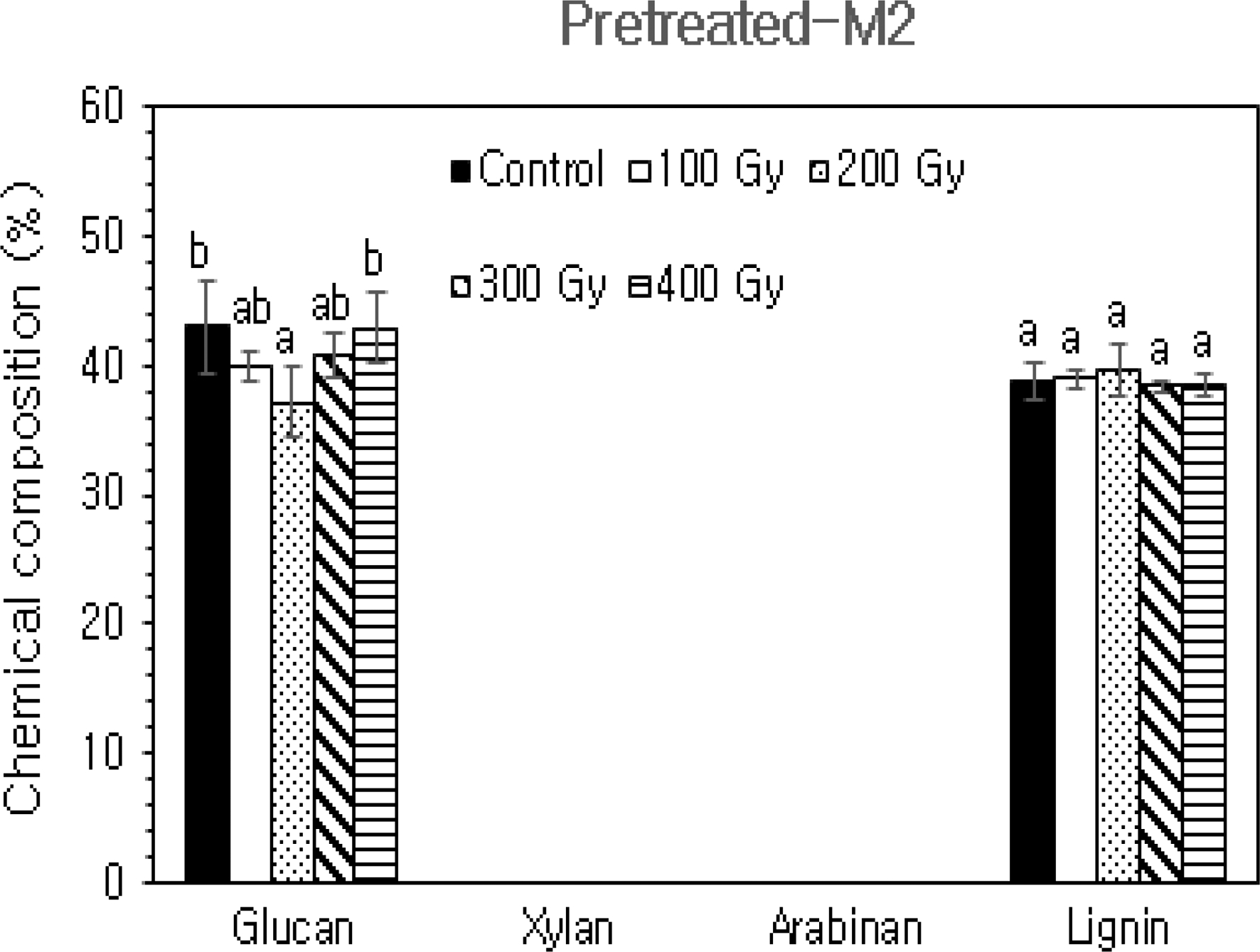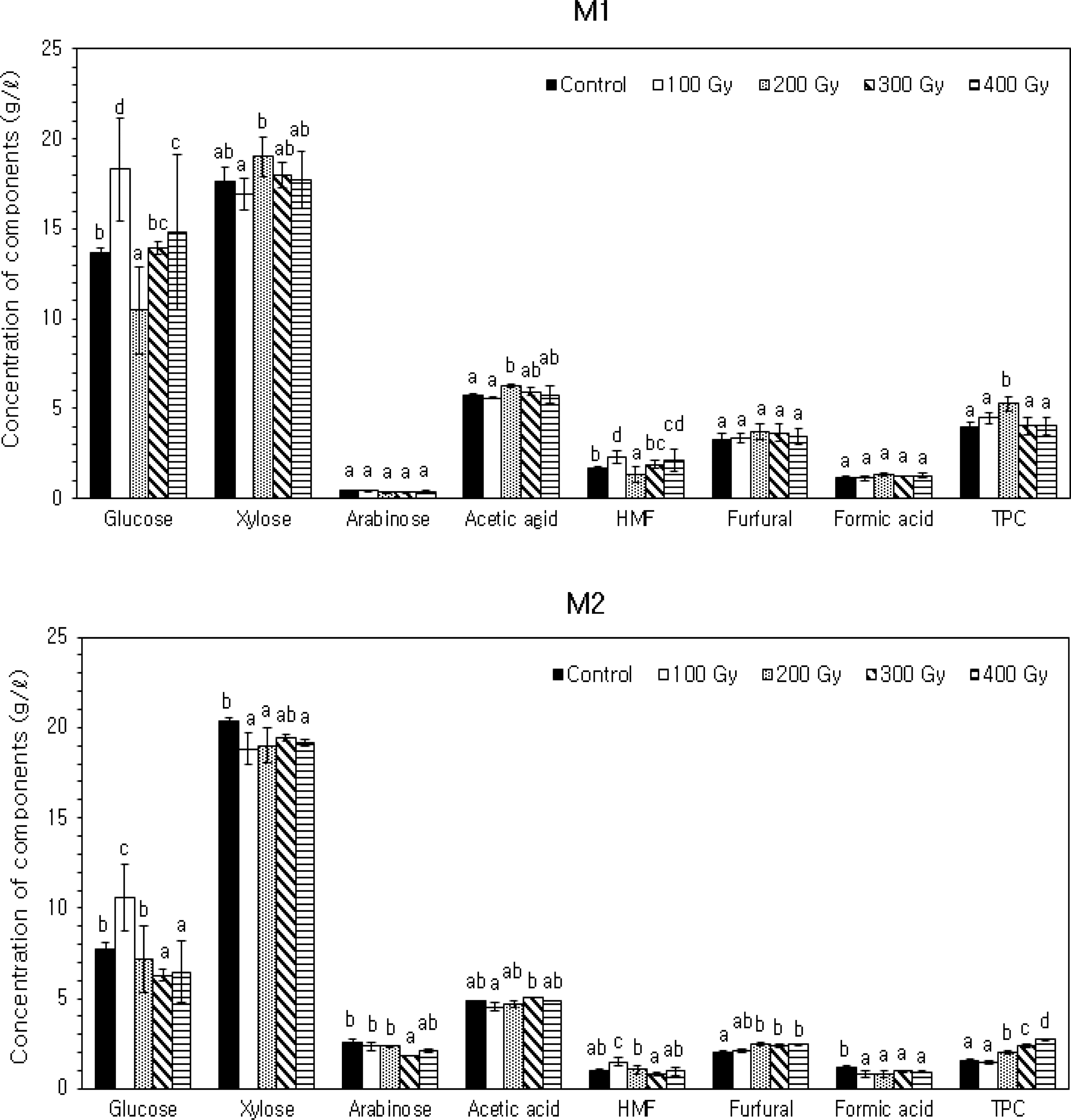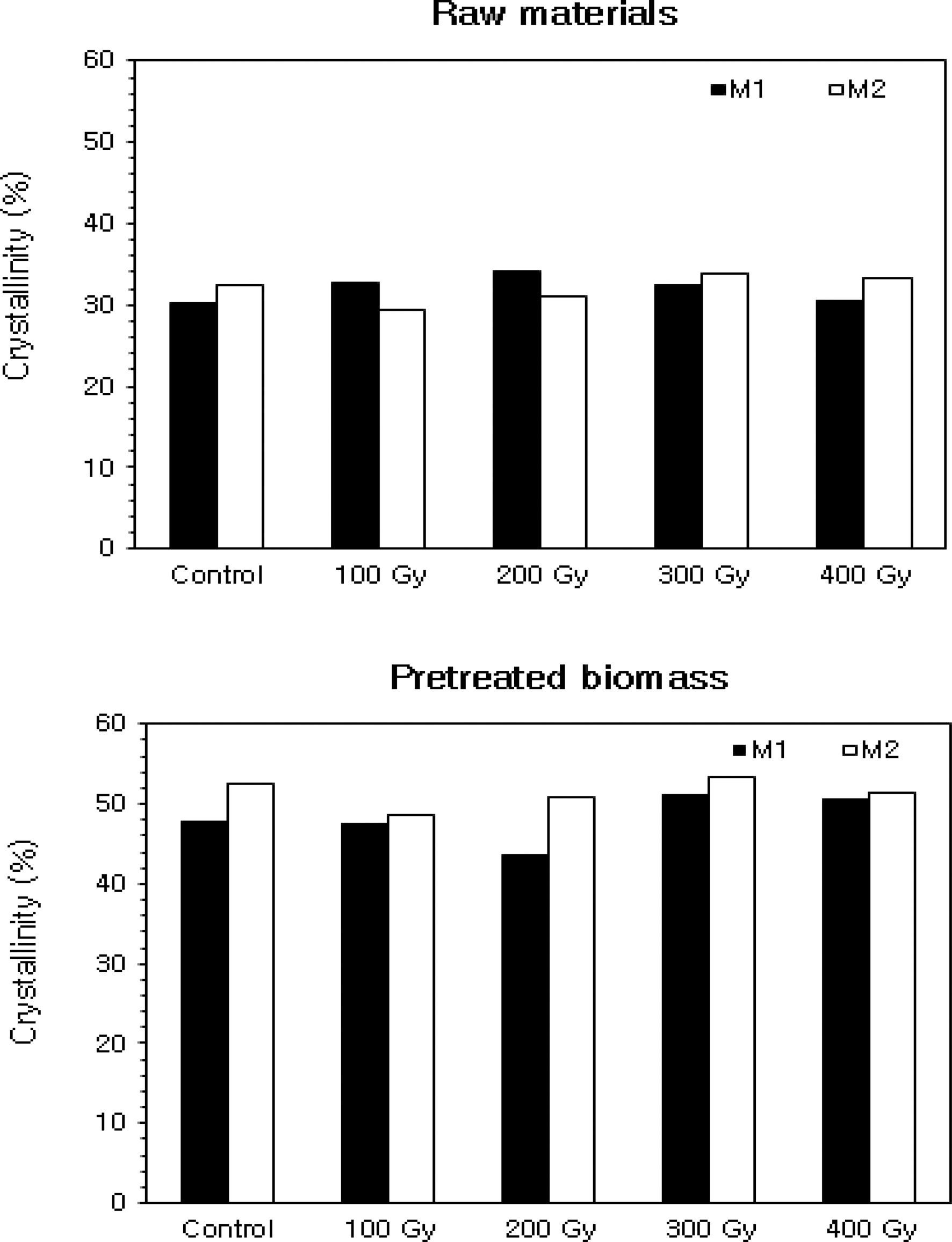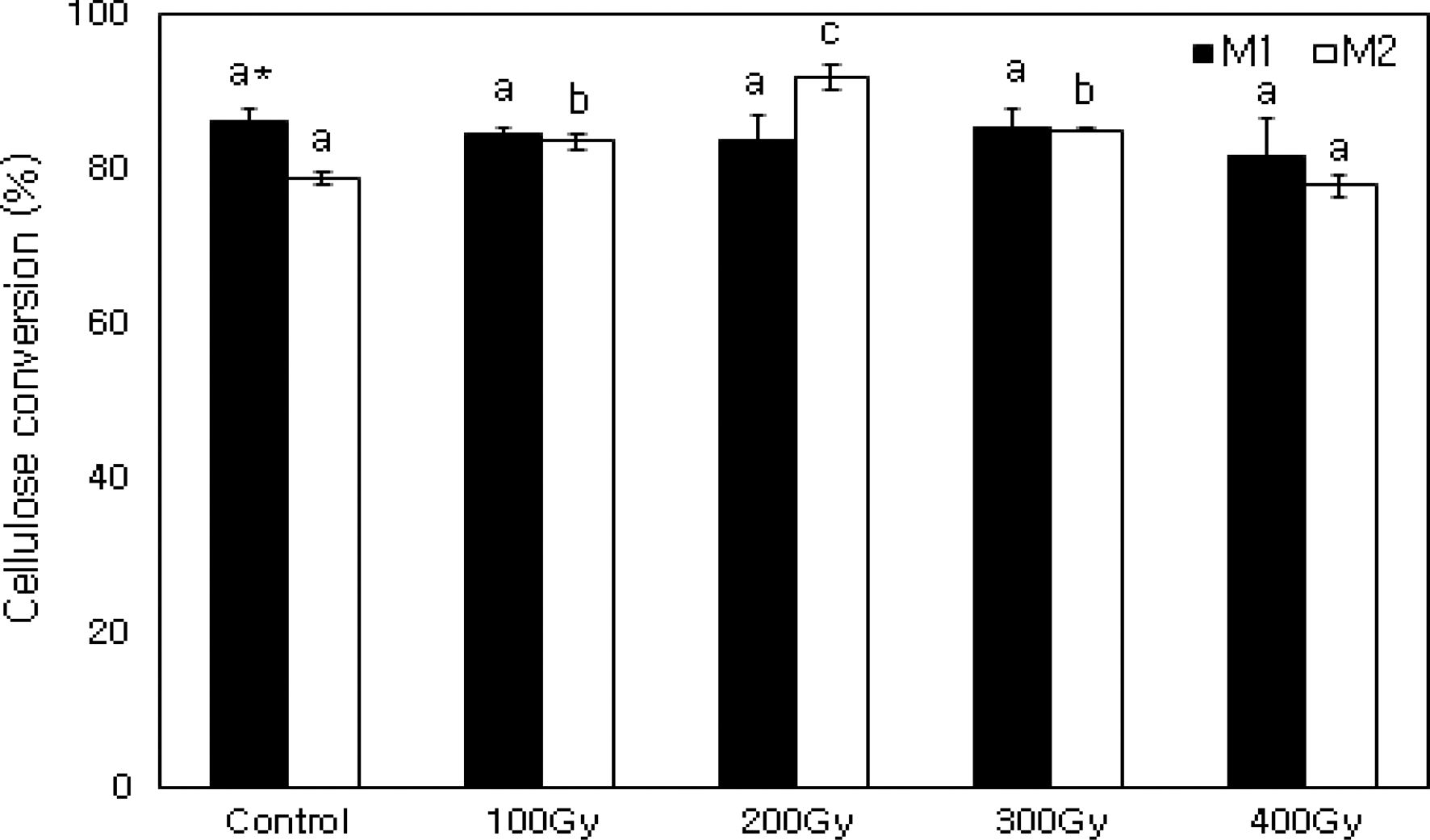
감마선 조사 처리에 의한 결명자 줄기의 전처리와 효소가수분해 효과
© The Korean Society of Medicinal Crop Science. All rights reserved.
This is an Open-Access article distributed under the terms of the Creative Commons Attribution Non-Commercial License ( http://creativecommons.org/licenses/by-nc/3.0 ) which permits unrestricted non-commercial use, distribution, and reproduction in any medium, provided the original work is properly cited.
Abstract
The demand of recycling renewable agricultural by-products is increasing. Radiation breeding is a method used to improve saccharification efficiency. Thus, we investigated the effect of gamma ray irradiation on the pretreatment and enzymatic hydrolysis of the stalks of Senna tora, an important medicinal plants.
S. tora seeds were irradiated with gamma ray at doses of 100, 200, 300, and 400 Gy. In the pretreated biomass, glucan and lignin content were higher in the M1 (1st generations of irradiation) S. tora stalks than in the M2 (2nd generations of irradiation) stalks, this can be explained by the higher degradation rate in M1. After oxalic acid pretreatment, the concentration of total phenolic compounds (TPCs) in the hydrolysate increased in the gamma ray treated seeds. The highest relative increase rate in crystallinity in the pretreated biomass was observed in M1-400 Gy and M2-100 Gy. The cellulose conversion rate was higher in M1 than in M2, except for 200 Gy.
Gamma ray irradiation at an appropriate dose can be used to improve the efficiency of pretreatment and enzymatic hydrolysis, thereby increasing biomass availability.
Keywords:
Senna tora Stalk, Gamma Ray Irradiation, Oxalic Acid Pretreatment, Enzymatic Hydrolysis서 언
화석에너지 고갈 및 에너지 파동 등의 위기상황에 대비한 에너지원의 다양화는 현재와 미래의 국가경쟁력을 좌우하는 새로운 동력으로 급부상하고 있다 (Jung et al., 2016).
현재 이용되어지고 있는 바이오매스로는 작물, 나무, 농산품, 축산 폐기물, 농업 및 산림 부산물 등이 있으며 지속가능하고 재생가능하다는 장점이 있다 (Ryu et al., 2011). 특히 유채, 콩, 옥수수, 사탕수수 등의 농산물은 대부분 식용으로 쓰이지 만 EU와 미국 등 선진국에서는 농산물 가격 안정을 위해 잉 여 농산물을 원료로 사용하여 수송용 바이오연료 (바이오에탄 올, 바이오디젤)를 만드는데 이용하고 있다. 에너지 작물 또는 부산물의 국산 원료를 이용하여 바이오연료를 생산함으로써 수입원유에 대한 의존도를 낮추어 에너지 안보를 제고할 수 있으며, 이산화탄소 감축효과를 기대할 수 있다 (Mansouri et al., 2016).
바이오매스는 셀룰로오스, 헤미셀룰로오스, 리그닌이 유기적 으로 결합되어 있는 구조로 바이오매스로부터 바이오에탄올을 생산하기 위해서는 전처리와 효소가수분해 공정이 필요하다 (Gupta et al., 2009). 전처리는 대부분의 헤미셀룰로오스와 일 부 리그닌을 분해 및 제거시켜 셀룰로오스에 대한 효소의 접 근성을 향상시킨다 (Kim et al., 2009).
일반적으로 암모니아, 알칼리, 황산을 촉매로 사용하여 전처 리가 수행된다. 그 중 황산을 이용한 산 전처리 방법은 비용 이 저렴하고, 높은 효율성을 가지고 있어 광범위하게 사용된 다. 그러나 반응기 부식과 환경오염을 야기하며, 대용량 공정 시 안전상의 문제점이 있다. 이러한 황산의 문제점을 해결하 기 위해 옥살산과 같은 유기산을 이용한 많은 연구들이 수행 되고 있다 (Kootstra et al., 2009).
약용작물 중 결명자 [Senna tora (L.) Roxb.]는 콩과의 일 년생 초본으로 전통적으로 눈을 밝게 하며 간 기능을 향상시 키는 작물로 알려져 있으며 항산화 물질인 페놀성 화합물을 다량 포함하여 항산화활성을 가지는 것으로 보고되었다 (Lim et al., 2004). 이러한 효능을 지니는 결명자 종자는 유용하게 활용되고 있지만 부산물로 생산되는 줄기부분의 바이오매스는 특별한 용도로 이용되지 못하고 버려지고 있는 실정이다.
국가통계포털 (KOSIS)의 ‘특용작물생산현황’ 통계자료에 의 하면 국내에서 생산된 약용작물 중 결명자는 2015 년, 2016 년에 각각 1.088 t/10 a, 4.088 t/10 a로 생산되는 것으로 보고된 다 (KOSIS, 2017). 현재 국내에서는 바이오매스의 수입의존율 이 높고 자급률이 현저히 낮다. 이러한 문제점을 해결하기 위 하여 매년 버려지고 있는 초본계 및 목질계 바이오매스 부산 물의 활용에 대한 다양한 연구들이 시도되고 있다 (Lee et al., 2017). 따라서 결명자 줄기는 버려지는 농업부산물의 재활 용 측면에서 에너지용 바이오매스로 활용이 가능할 것으로 판 단된다.
작물의 이용을 위한 육종 및 개량 방법으로 감마선 조사 방 법이 있다. 감마선을 이용한 인위적인 돌연변이는 기존의 우 량형질을 유지하면서 육종가가 원하는 유전형질만을 개량할 수 있고 육종기간도 단축시킨다. 창출된 유용형질 변이체는 신 품종 육성의 육종모재로 활용할 수 있어 감마선 조사 효과가 각광받고 있다 (Kim et al., 2008).
최근에는 바이오매스의 당화 효율을 증가시키기 위한 방법 으로 감마선 조사에 대한 연구가 활발하게 이루어지고 있다. 감마선을 조사한 후 산 전처리를 수행함으로써 당화 효율을 증가시킬 수 있다는 연구결과가 보고되고 있다 (Kim et al., 2016).
감마선이 목질계 바이오매스의 구조를 변형시켜 셀룰로오스, 헤미셀룰로오스, 리그닌의 분해를 유도하여 촉매가 바이오매 스 내로 쉽게 침투하고 셀룰로오스의 분해 속도가 증가하여 효소가수분해 효과를 향상시켰다 (Xin and Kumakura, 1993; Binod et al., 2010). 하지만 바이오매스에 직접 감마선을 조 사한 연구가 대부분이며 종자에 조사하여 바이오매스의 전처 리 효과를 확인한 연구는 거의 없는 실정이다. 감마선은 고분 자 재료를 분해할 수 있는 에너지로 이를 이용하면 바이오매 스의 효율적인 분해가 가능하다.
따라서 본 연구에서는 결명자 종자에 감마선을 조사한 후 조사량에 따른 결명자 줄기의 전처리 및 효소가수분해 효율을 확인하고자 한다.
재료 및 방법
1. 공시재료
본 실험은 2014 - 2016 년 정읍 한국원자력연구소 감마선 조사 시설 (Co-60 3,000 Ci, Nordion Inc., Ottawa, ON, Canada) 내에서 방사선 (100 - 400 Gy)이 처리된 결명자 [Senna tora (L.) Roxb.]종자로부터 뿌리와 가지를 제거한 후 줄기만을 수집하여 실험에 사용하였다. 종자는 105 개의 칸이 있는 트레이에 상토를 넣고 깊이 2㎝의 구멍을 뚫어 종자를 1 립씩 심어 25℃의 일정한 온도 하에 발아시킨 후, 전남대학 교 포장에서 30㎝ 간격으로 이식 하여 재배하였다.
감마선을 조사한 결명자 종자를 다시 재배하여 얻어진 다음 세대의 결명자 줄기를 M1, 그 다음 세대의 결명자 줄기를 M2로 명명하였다. 본 연구에서는 감마선 조사 유무에 따른 줄 기의 전처리 및 당화 효과를 비교하기 위하여 감마선을 조사 하지 않은 결명자를 대조구 (control)로 이용하였다. 결명자 줄 기는 각 처리구당 임의로 고르게 수확 후 분쇄하여 20 - 80 mesh 크기로 분리하여 전처리에 사용하였다.
2. 바이오매스의 옥살산 전처리
감마선 조사량에 따른 결명자 줄기의 옥살산 전처리 효과를 비교하기 위해 전건시료 25 g과 옥살산 촉매 용액 (0.1M, pH 1.3)200㎖를 혼합하여 170℃에서 60 분간 회전식 반응기 (rotating digester/DM-848, Daeil Science Co., Ltd., Seoul, Korea)에서 전처리를 수행하였다. 반응종료 후 반응기를 15 분 간 급랭시켰으며, 고형바이오매스와 액상가수분해산물을 여과 ·분리하여 4℃에서 냉장 보관하였다.
3. 고형바이오매스 및 액상가수분해산물 성분분석
전처리 전후 고형바이오매스 구성성분 분석은 NREL (laboratory analytical procedure determination of structural carbohydrates and lignin in biomass)방법에 의해 수행하였다 (Sluiter et al., 2008).
전처리 후 액상가수분해산물 내의 주요 당 (글루코오스, 자 일로스, 아라비노스), 유기산 (acetic acid)및 당 분해산물 [furfural, 5-hydromethylfurfural (HMF)]은 HPLC (e2695, Waters, Milford, MA, USA)를 이용하여 분석하였다. 컬럼은 aminex 87 H (300 × 7.8㎜, BIO-RAD, Hercules, CA, USA)를 사용하였으며 refractive index detecter (2414, Waters, Milford, MA, USA)를 사용하였다. 이동상은 5mM H2SO4을 flow rate 0.6㎖/min으로 55 분 동안 분석하였다.
액상가수분해산물에 포함되어 있는 총 페놀화합물 (total phenolic compounds, TPC)의 함량은 Folin-Ciocalteu’s reagent 방법 (Singleton et al., 1999)으로 UV-VIS spectrophotometer (UV 1800, Shimadzu, Kyoto, Japan)을 사용하여 측정하였다 (Singleton et al., 1999).
4. X-ray diffraction (XRD)분석
고형바이오매스의 결정화도 분석은 3D high resolution Xray diffractometer (EMPYREAN, PANalytical, Almelo, Netherlands)를 이용하여 2 θ = 5 - 50°의 범위에서 가속전압 40 kV, 30 mÅ의 분석조건으로 감마선 조사량에 따라 측정하 였다. 시료에 대한 결정성 영역 (CrI)은 Segal법에 의해 다음 과 같은 식으로 계산하였다 (Roncero et al., 2005; Yang et al., 2009).
5. 효소가수분해
감마선 조사량에 따른 전처리 결명자 줄기의 당화 수율을 평가하기 위하여 효소가수분해를 실시하였다. 전건시료 4 g의 전처리 바이오매스에 sodium citrate buffer (0.1M, pH 4.8)40㎖를 첨가하였다. 30℃, 150 rpm 조건에서 1 시간 동 안 shaking incubator (JSSI-100C, JS Research Inc., Gongju, Korea)에서 교반한 후, pH 4.8로 조절하였다. Autoclave (HB-506, Hanbaek Scientific Technology Co., Ltd., Bucheon, Korea)에서 121℃, 15 분간 멸균시킨 후, Cellic CTec2 효소를 바이오매스 g당 120㎕ 첨가하였다. 효 소 첨가 후 50℃에서 150 rpm으로 교반하면서 96 시간까지 24 시간 간격으로 1㎖씩 sample을 채취하였다.
효소가수분해 과정에서 생산된 단당류 농도는 HPLC (e2695, Waters, Milford, MA, USA)를 이용하여 측정하였다. 분석용 시료는 모두 0.45㎛ filter를 통과시켜 적절한 희석배 율을 적용하여 분석을 실시하였다.
6. 통계분석
감마선 조사량과 세대별 결명자 줄기의 전처리, 효소가수분 해 효과를 확인하기 위하여 Two-way ANOVA 분석을 실시하 였다. 결과의 통계적 유의성은 p value 0.05 미만일 경우 유 의성이 있다고 판단하였으며 IBM SPSS Statistics 23 (SPSS Inc., Chicago, IL, USA)을 사용하여 분석하였다.
결과 및 고찰
1. 고형바이오매스 성분분석
감마선 조사량별, 세대별 구성성분의 차이를 확인하기 위해 통계분석을 수행하였다.
전처리 전 감마선 조사량별 통계분석 결과, M1 내 100 Gy 와 200 Gy 조건 사이에서 글루칸, 자이란, 리그닌 등 주요 구성성분 함량의 유의미한 차이가 있음을 확인하였다. 100 Gy 와 비교하여 200 Gy에서 자이란과 리그닌의 함량이 각각 17.55%, 17.12% 높게 나타났으며, 글루칸 함량은 9.37% 낮게 나타났다 (Fig. 1).

Chemical compositions of Senna tora stalk treated by gamma ray irradiation.The same lines are significantly different at the 5% level between dose of gamma rays each generation. Mean values ± SD from triplicate separated experiments are shown. *Different superscripts letters (a - d) within a column show significant differences at p < 0.05 between dose of gamma rays in each generations by Tukey’s HSD test.
M2 내 평균 리그닌의 함량은 대조구, 100, 200 Gy 조건과 비교하여 감마선 조사량이 강한 300, 400 Gy 조건에서 11.44% 높게 나타났다 (Fig. 1). 전처리 전 세대별 통계분석 결과, 글루칸과 아라비난에서 유의적 차이가 나타났으며, 전체 적으로 M1 (글루칸; 36.55%, 아라비난; 0.50%)과 비교하여 M2 (32.52%, 2.65%)에서 글루칸의 함량은 감소하고 아라비난 의 함량이 증가하였다.
전처리 후 감마선 조사량별 통계분석 결과, M1에서는 주요 구성성분 함량의 차이가 없었으며, M2 내 대조구와 200 Gy 조건 사이에서 글루칸 함량은 각각 43.02%, 37.11%로 유의미 한 차이가 나타났다.
전처리 후 바이오매스로부터 글루칸과 리그닌의 평균 함량 이 전처리 전과 비교하여 M1에서 각각 43.59%, 78.65%, M2에서 각각 25.35%, 58.39% 로 상대적으로 증가하였으며, 이는 전형적인 옥살산 전처리 효과와 일치하였다 (Lee et al., 2009). 전처리 후 바이오매스 내 글루칸과 리그닌 함량의 상 대적 증가율은 M2와 비교하여 M1에서 모두 높게 나타났다 (Fig. 1). 이것은 평균 분해율 M1에서 42.49%, M2에서 35.33%로 M1에서의 높은 분해율에 의한 것으로 사료된다 (Table 1).
감마선은 목질계 바이오매스 성분 중 셀룰로오스의 β-1,4- glucosidic bonds를 선택적으로 분해하는 것으로 알려져 있으 며, 50, 100, 200 kGy의 감마선을 바이오매스에 조사하였을 때 감마선 조사량이 증가할수록 리그닌과 같은 고분자 물질을 분해하는데 효과적이라고 보고된 바 있다 (Kim et al., 2016).
2. 액상가수분해산물 성분분석
M1, M2 결명자 [Senna tora (L.) Roxb.]줄기 액상가수분해 산물의 주요 성분은 자일로스로 확인되었으며, 글루코오스 생 산량은 자일로스에 비해 낮게 나타났다 (Fig. 2).

Sugar and inhibitors in hydrolysate during oxalic acid pretreatment.Mean values ± SD from triplicate separated experiments are shown. *Different superscripts letters (a - d) within a column show significant differences at p < 0.05 between dose of gamma rays in each generations by Tukey’s HSD test.
이는 옥살산 전처리의 전형적인 특징으로 헤미셀룰로오스가 선택적으로 분해되었음을 의미한다 (Jeong et al., 2014). 옥살 산에 의한 헤미셀룰로오스의 선택적인 분해는 효소의 접근성 을 향상시켜 효소가수분해 효과를 촉진시킬 것이다 (Kim et al., 2011). M1의 100 Gy 조건에서 자일로스 보다 높은 글루 코오스 함량은 분해율이 44.89%로 높아서 나타난 현상으로 판 단된다 (Table 1).
액상가수분해산물 내에는 발효저해물질로 알려진 acetic acid, furfural, HMF, TPC 등이 검출되었다 (Scordia et al., 2013). 발효공정에 있어 2 g/ℓ 이상의 HMF, furfural 농도는 에탄올 생산에 부정적인 영향을 주는 것으로 알려져 있다 (Castro et al., 2011). Furfural 함량이 HMF에 비해 상대적으로 높게 나 타났으며, 이는 단당류의 분해속도 차이에 의한 것으로 글루 코오스 보다 자일로스 분해가 촉진되었음을 의미한다 (Jang et al., 2015). TPC는 리그닌 분해산물 중 페놀성 화합물을 나타 내는 것으로, 이것은 옥살산 전처리에 의해 부분적으로 리그 닌의 분해가 이루어졌음을 나타낸다.
감마선 조사별 액상가수분해산물 내 평균 성분함량 비교 결 과, M1 내 100 Gy 조건에서 당 농도는 가장 높고 발효저해 물질의 농도는 가장 낮게 나타났다. 반면, 200 Gy 조건에서는 가장 낮은 농도의 당과 가장 높은 농도의 발효저해물질이 검 출되었다. M2에서는 감마선 조사량이 증가할수록 당 농도는 점차 감소하고 발효저해물질의 농도가 증가하는 경향이 관찰 되었다. 모든 세대에서 감마선 조사 조건 중 100 Gy에서 가 장 높은 농도의 당과 낮은 농도의 발효저해물질이 생산되었음 은 당의 과분해가 천천히 진행된 결과로 보인다.
세대별 액상가수분해산물 내 평균 성분함량 비교 결과, 글 루코오스와 TPC는 M2 (7.65, 2.02 g/ℓ)와 비교하여 M1 (14.22, 4.35 g/ℓ)에서 높은 농도로 생산되었으며, 자일로스는 M1 (17.85 g/ℓ)과 비교하여 M2 (19.35 g/ℓ)에서 높은 농도 로 생산되었다. 이것은 전처리 전 고형바이오매스 내 성분함 량의 영향을 받은 것으로 사료된다. M1, M2에서 대조구 조건 과 비교하여 감마선 처리에 의해 TPC 농도가 증가하였으며, 특히 감마선 조사량이 증가함에 따라 TPC 농도가 증가하는 경향을 확인하였다 (Fig. 1).
3. 고형바이오매스의 구조적 특성 분석
전처리 전후 결명자 줄기의 결정화도를 측정하기 위해 XRD 분석을 수행하였다 (Fig. 3). 결정화도 분석 결과, 전처리 전 바이오매스의 결정화도는 M1에서 30.08 - 34.19%, M2에서 30.97 - 33.21%로 나타났다. M1에서 감마선 조사량이 200 Gy 까지 증가할수록 결정화도가 증가하였으며, 300 Gy 이상에서 는 감소하였다. 전처리 후 결정화도는 전처리 전 바이오매스 와 비교하여 모두 증가하였다. 이것은 전처리에 의한 셀룰로 오스의 비결정성 영역과 자이란의 분해 때문이다 (Sun et al., 2014).

Change in the crystallinity value of Senna tora stalk by oxalic acid pretreatment at various gamma rays irradiation.
전처리 바이오매스로부터 각 세대에서 감마선 조사량에 따 른 결정화도는 일정한 경향이 관찰되지 않았다. 전처리 후 결 명자 줄기의 평균 결정화도는 M1 (48.08%)과 비교하여 M2 (51.34%)에서 높게 나타났다. 전처리 후 바이오매스 결정화도 의 증가율을 비교하였을 때, 각 세대 내 감마선 조사량에 따 른 가장 큰 증가율은 M1의 400 Gy에서 66.16%, M2의 100 Gy에서 66.30%로 나타났으며, 세대별 평균 증가율은 M1에서 50.88%, M2에서 60.71%로 나타났다. 따라서 세대를 거듭해서 (M2)낮은 감마선 조사량 조건에서 산 전처리에 의해 비결정 성 영역의 분해가 더 촉진된 것으로 사료된다.
4. 효소가수분해
목질계 바이오매스의 구성성분 중 가장 많은 부분을 차지하 는 셀룰로오스는 효소가수분해에 의해 에탄올로 전환 가능한 글루코오스로 분해된다 (Zhang and Lynd, 2004; Zhao et al., 2008). 효소가수분해 후 결명자 줄기로부터 생성된 환원당 중에서 글루코오스의 함량은 HPLC를 통해 확인하였으며, 셀 룰로오스 전환율에 대한 결과는 Fig. 4와 같다.

Cellulose conversion efficiency by enzymatic hydrolysis.*Different superscripts letters (a – c) within a column show significant differences at p < 0.001 between dose of gamma rays in 2nd generation by Tukey’s HSD test.
전처리에 의한 자이란 분해는 효소가수분해 동안 셀룰로오 스 분해를 촉진하였으며, 이것은 자이란이 분해되어 셀룰로오 스로에 대한 효소의 접근이 쉬어졌다는 이론을 뒷받침해주고 있다 (Berlin et al., 2006).
당화율은 감마선 조사량이 증가함에 따라 M1에서 일정한 경향이 관찰되지 않았지만, M2에서는 감마선 조사량이 200 Gy까지 증가할수록 당화율이 증가하였으며 300 Gy 이상에서 는 감소하였다.
각 세대 내 감마선 조사량에 따른 당화율의 차이를 확인하 기 위해 이원배치 분산분석을 실시한 결과, M1에서 유의확률 p > 0.05로 감마선 조사량에 따른 당화율에 차이가 없음을 확 인하였다. 반면 M2에서는 p < 0.001로 감마선 조사량에 따라 당화율에 있어 유의미한 차이가 나타났다. 또한, 세대별 당화 율의 차이가 검증되어 효소 가수분해 96 시간 후, M1 전처리 결명자 줄기의 대조구를 포함한 모든 감마선 조사량 조건에서 50 g/ℓ 이상의 발효가능한 당이 생산되었으며, M2 전처리 결 명자 줄기로부터는 대조구와 모든 감마선조사량 조건에서 39 g/ℓ 이상의 발효가능한 당이 생산되었다.
이것은 M1 전처리 결명자 줄기에서 관찰된 높은 분해율과 낮은 결정화도에 의한 것으로 사료된다. 결과적으로, 결명자줄 기를 이용한 효율적인 바이오매스 생산을 위해서 100 Gy 보 다 낮은 방사선량의 추후 검증과 M3 세대의 개별검증이 이루 어진다면 식용 이외의 결명자 잉여 농산물을 활용한 효율적인 바이오매스로의 활용으로 이루어질 수 있겠다.
이러한 결과는 바이오매스의 전처리 및 효소가수분해 효율 을 향상시킬 수 있는 적절한 감마선량의 조사가 바이오매스 활용 가능성을 증가시킬 수 있음을 의미한다.
References
-
Berlin, A, Balakshin, M, Gilkes, N, Kadla, J, Maximenko, V, Kubo, S, Saddler, J, (2006), Inhibition of cellulase, xylanase and β-glucosidase activities by softwood ligninpreparations., J. Biotechnol, 125, p198-209.
[https://doi.org/10.1016/j.jbiotec.2006.02.021]

-
Binod, P, Sindhu, R, Singhania, R.R, Vikram, S, Devi, L, Nagalakshmi, S, Kurien, N, Sukumaran, R.K, Pandey, A, (2010), Bioethanol production from rice straw: An overview., Bioresour. Technol, 101, p4767-4774.
[https://doi.org/10.1016/j.biortech.2009.10.079]

-
Castro, E, DA-az, M.J, Cara, C, Ruiz, E, Romero, I, Moya, M, (2011), Dilute acid pretreatment of rapeseed straw for fermentable sugar generation., Bioresour. Technol, 102, p1270-1276.
[https://doi.org/10.1016/j.biortech.2010.08.057]

-
Gupta, R, Sharma, K.K, Kuhad, R.C, (2009), Separate hydrolysis and fermentation(SHF) of Prosopis juliflora, a woody substrate, for the production of cellulosic ethanol by Saccharomyces cerevisiae and Pichia stipitis-NCIM 3498., Bioresour. Technol, 100, p1214-1220.
[https://doi.org/10.1016/j.biortech.2008.08.033]

-
Jang, S.K, Jeong, H.S, Hong, C.Y, Kim, H.Y, Ryu, G.H, Yeo, H.M, Choi, J.W, Choi, I.G, (2015), Changes of furfural and levulinic acid yield from small-diameter Quercus mongolica depending on dilute acid pretreatment conditions., Journal of the Korean Wood Science and Technology, 43, p838-850.
[https://doi.org/10.5658/wood.2015.43.6.838]

-
Jeong, S.Y, Trinh, L.T.P, Lee, H.J, Lee, J.W, (2014), Improvement of the fermentability of oxalic acid hydrolysates by detoxification using electrodialysis and adsorption., Bioresour. Technol, 152, p444-449.
[https://doi.org/10.1016/j.biortech.2013.11.029]

-
Jung, J.Y, Lee, Y, Lee, E.Y, (2016), Value-added utilization of lignin residue from pretreatment process of lignocellulosic biomass., Applied Chemistry for Engineering, 27, p135-144.
[https://doi.org/10.14478/ace.2016.1016]

- Kim, D.H, Park, H.W, Park, C.G, Sung, J.S, Seong, N.S, (2008), Effect of gamma irradiation on the germination and growth of Astragalus membranaceus., Hanguk Yakyong Changmul Hakhoe Chi, 16, p238-241.
-
Kim, H.Y, Lee, J.W, Jeffries, T.W, Choi, I.G, (2011), Evaluation of oxalic acid pretreatment condition using response surface method for producing bio-ethanol from yellow poplar (Liriodendron tulipifera) by simultaneous saccharification and fermentation., Journal of the Korean Wood Science and Technology, 39, p75-85.
[https://doi.org/10.5658/wood.2011.39.1.75]

- Kim, H.Y, Lee, J.W, Jeffries, T.W, Gwak, K.S, Choi, I.G, (2009), Effect of oxalic acid pretreatment on yellow poplar (Liriodendron tulipifera) for ethanol production., Journal of the Korean Wood Science and Technology, 37, p397-405.
-
Kim, S.M, Choi, J.I, Joe, M.H, Kim, J.D, (2016), Effect of gamma irradiation on wood chip saccharification pretreated with NaOH., Korean Chemical Engineering Research, 54, p431-435.
[https://doi.org/10.9713/kcer.2016.54.3.431]

-
Kootstra, A.M.J, Beeftink, H.H, Scott, E.L, Sanders, J.P.M, (2009), Comparison of dilute mineral and organic acid pretreatment for enzymatic hydrolysis of wheat straw., Biochem. Eng. J, 46, p126-131.
[https://doi.org/10.1016/j.bej.2009.04.020]

- KOSIS, (2017), Special crop production status, Korean Statistical Information Service., Daejeon, Korea., http://kosis.kr/wnsearch/totalSearch.jsp.
-
Lee, C.G, Lee, S.Y, Joo, S.Y, Cho, L.H, Park, S.Y, Lee, S.H, Oh, K.C, Kim, D.H, (2017), A study on agricultural by-products for biomass-to-energy conversion and Korean collecting model., New and Renewable Energy, 13, p27-35.
[https://doi.org/10.7849/ksnre.2017.3.13.1.027]

-
Lee, J.W, Rodrigues, R.C.L.B, Jeffries, T.W, (2009), Simultaneous saccharification and ethanol fermentation of oxalic acid pretreated corncob assessed with response surface methodology., Bioresour. Technol, 100, p6307-6311.
[https://doi.org/10.1016/j.biortech.2009.06.088]

- Lim, J.D, Yu, C.Y, Kim, M.J, Yun, S.J, Lee, S.J, Kim, N.Y, Chung, I.M, (2004), Comparison of SOD activity and phenolic compound contents in various Korean medicinal plants., Hanguk Yakyong Changmul Hakhoe Chi, 12, p191-202.
-
Mansouri, A, Rihani, R, Laoufi, A.N, A-zkan, M, (2016), Production of bioethanol from a mixture of agricultural feedstocks: Biofuels characterization., Fuel, 185, p612-621.
[https://doi.org/10.1016/j.fuel.2016.08.008]

-
Roncero, M.B, Torres, A.L, Colom, J.F, Vidal, T, (2005), The effect of xylanase on lignocellulosic components during the bleaching of wood pulps., Bioresour. Technol, 96, p21-30.
[https://doi.org/10.1016/j.biortech.2004.03.003]

- Ryu, J.S, Kim, K.S, Park, S.J, (2011), A study on combustion characteristics of wood biomass for cogeneration plant., Applied Chemistry for Engineering, 22, p296-300.
-
Scordia, D, Cosentino, S.L, Jeffries, T.W, (2013), Effectiveness of dilute oxalic acid pretreatment of MiscanthusA-giganteus biomass for ethanol production., Biomass Bioenergy, 59, p540-548.
[https://doi.org/10.1016/j.biombioe.2013.09.011]

- Singleton, V.L, Orthofer, R, Lamuela-Raventós, R.M, (1999), Analysis of total phenols and other oxidation substrates and antioxidants by means of folin-ciocalteu reagent., Methods Enzymol, 299, p152-178.
- Sluiter, A, Hames, B, Ruiz, R, Scarlata, C, Sluiter, J, Templeton, D, Crocker, D, (2008), Determination of structural carbohydrates and lignin in biomass: Laboratory analytical procedure, National Renewable Energy Laboratory, Golden. CO, USA., https://www.nrel.gov/docs/gen/fy13/42618.pdf.
-
Sun, S.N, Cao, X.F, Zhang, X.M, Xu, F, Sun, R.C, Jones, G.L, (2014), Characteristics and enzymatic hydrolysis of cellulose-rich fractions from steam exploded and sequentially alkali delignified bamboo(Phyllostachys pubescens)., Bioresour. Technol, 163, p377-380.
[https://doi.org/10.1016/j.biortech.2014.04.082]

-
Xin, L.Z, Kumakura, M, (1993), Effect of radiation pretreatment on enzymatic hydrolysis of rice straw with low concentrations of alkali solution., Bioresour. Technol, 43, p13-17.
[https://doi.org/10.1016/0960-8524(93)90076-n]

-
Yang, S, Li, J, Zheng, Z, Meng, Z, (2009), Lignocellulosic structural changes of Spartina alterniflora after anaerobic monoand co-digestion., Int. Biodeterior. Biodegradation, 63, p569-575.
[https://doi.org/10.1016/j.ibiod.2009.02.007]

-
Zhang, Y.H.P, Lynd, L.R, (2004), Toward and aggregated understanding of enzymatic hydrolysis of cellulose: Noncomplexed cellulase systems., Biotechnol. Bioeng, 88, p797-824.
[https://doi.org/10.1002/bit.20282]

-
Zhao, L, Zhang, X, Tan, T, (2008), Influence of various glucose/xylose mixtures on ethanol production by Pachysolen tannophilus., Biomass Bioenergy, 32, p1156-1161.
[https://doi.org/10.1016/j.biombioe.2008.02.011]

